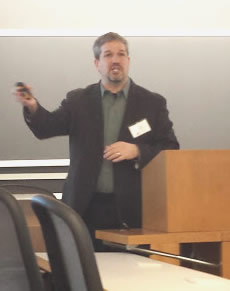The Rise of Angel Capital to Fund 21st Century Entrepreneurship
Halpern keynote gives bird’s eye view of angel investing landscape

Jeremy Halpern offered an upbeat overview of a thriving segment of the economy in his lecture, the Rise of Angel Capital to Fund 21st Century Entrepreneurship, at Boston University School of Law on Friday, February 27, 2015. Halpern, a partner and the director of the Business Development for the Emerging Companies group at Nutter, McClennen, and Fish, LLP, and the firm’s self-titled “entrepreneur in residence,” spoke at the BU Law Review of Banking and Financial Law symposium, Innovation Today: The Legal Challenges of Funding Startups.
After a quick introduction by James E. Scott, director of the Graduate Program in Banking & Financial Law, Halpern jumped right into an outline of the trajectory of the angel investing marketplace. Overall, he said, “the round sizes are going up.” However, the second quarter of 2014 saw a dip in the median and mean angel round sizes; both statistics had been on an upward trajectory before then.
“It’s not clear what’s happening” with the dip, he said.
He also noted a few other trends: angels are investing conservatively, and they’re increasing round sizes when they invest with “non-angels.” Sector-wise, health care investment round sizes have gone up, while telecom and Internet have gone down.
While venture capital investment numbers are more reliably reported, trends overall are relatively similar, Halpern said. One notable trend, according to Halpern: “there are fewer deals and more dollars” in venture capital, and more later-stage deals in general.
“This is really freaking people out,” he said.
Halpern sees a shift in who are becoming entrepreneurs today, with people having many more jobs before they retire, and startup costs dropping.
“The path to wealth has changed,” he said. “The opportunity cost [of entrepreneurship] has gone way down.”
Today, we have an “incubator on every corner,” nurturing new businesses, as well as a “sea change” in how we think about the people at the top, Halpern said. Yesterday’s titans of industry are today’s “rock star” businesspeople, he said. They’re household names and entertainers on programs like Shark Tank.
Venture capitalists (VCs), Halpern said, are “banking the equity—they’re not banking the company,” and “venture capital returns are not doing well,” either.
That means companies looking for new sources of funding in early stages. Government-backed support is problematic, Halpern said, because of the limited resources and their role as “political footballs,” subject to the whims of lawmakers. Places like Boston are appealing, he said, but places like North Dakota or Connecticut are stepping up to lure in businesses that wouldn’t otherwise be attracted to a less popular place.
Halpern then introduced “two things that work well together:” the “lean startup movement” pushing better and more efficient companies, and entrepreneurs learning to “stretch a buck.” This translates to businesses “learning to do more on $900,000,” he said.
These two trends run alongside angel investors “getting professional … and proliferating,” he said.
“And they’ve gotten smarter,” Halpern said of angel investors. The “unintended consequences” of this growth and sophistication have been groups forced to “use more money,” he said, which has made it harder for businesses seeking smaller investments.
“You can get $750,000,” Halpern said, “but the groups won’t talk to you if you need $250,000.”
Investors are seeking more information before they invest, too, and “deal syndication” is on the rise, he said. Deal syndication occurs when investors offer a business part of what it needs and help them get the rest—in other words, Halpern said, they’ve created an oligopoly.
Stepping back, Halpern assessed the strengths and weaknesses of the angel investors themselves, as well as the groups they organize themselves into, from the point of view of a person seeking investors.
“Most of the angels in town will tell you they don’t want deals with VCs in them,” he said, yet virtually all of the deals that they’ve made money on have had VCs involved.
In layman’s terms, Halpern said, angel investors can be “know-it-alls.” Additionally, since angel investors are ultimately, typically, making individual decisions, as an investor, it’s “a bunch of people you have to go track down.” They are also picky about which industries are worth investment, favoring software, mobile, and biotech, among others, while avoiding clean tech, services, and food and beverage industries.
“If angels are the saviors of the ecosystem,” Halpern asked, “what are the threats?”
His answer includes taxes, foreign and micro VCs, regulations, and other complications in the investing “ecosystem.”
“Do I think crowdfunding is a threat? No, I do not,” Halpern said. “The overproliferation of crowdfunding sites will lead to diffusion.”
He asked the audience to name just three of the more than 50 crowdfunding sites—and no one could. Further, Halpern said, “Angels have made it crystal clear … that they will not invest in companies that were previously crowdfunded.”
His prediction: None of these threats is a deal-breaker. “Angels will, more likely than not, continue to carry the load for early-stage investing.”
“We have a really vibrant ecosystem as a result of this capital,” Halpern concluded.
Panels at the one-day symposium included Current Events in Startup Financing, Platform Compliance With Securities Laws, State Crowdfunding and the Intrastate Exemption Under Federal Securities Laws—Less Than Meets the Eye?, and The Nonpecuniary Benefits of Securities Crowdfunding.
For more information on this symposium, visit the Review of Banking & Financial Law‘s website.
Reported by Jaime Margolis (’16)